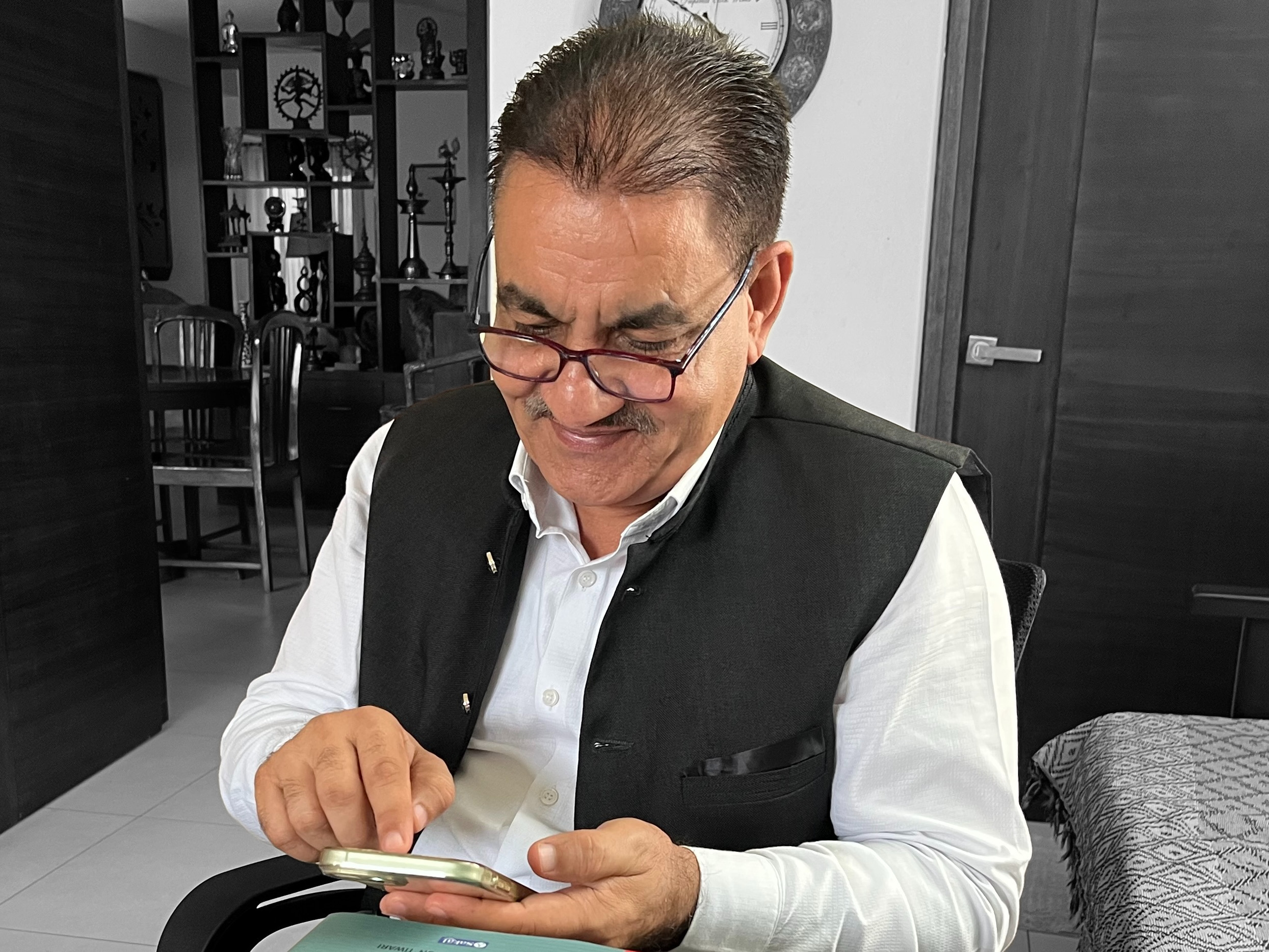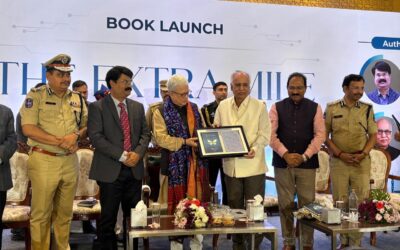
Green Leaders
I graduated in Mechanical Engineering from G.B. Pant University of Agriculture and Technology (GBPUAT) in the 1970s. I stayed there for ten years, earning a master’s degree and working as a teaching associate, before joining DRDO in 1982. During this period, I developed a profound respect for agricultural science and formed many lasting friendships. Many alumni of Pantnagar have worked at the International Crops Research Institute for the Semi-Arid Tropics (ICRISAT) in Hyderabad, including Dr. S.P.S. Beniwal, Dr. S.N. Nigam, and Dr. K.B. Saxena, with whom we have remained connected.
As time passed, I met many alumni from later years, includingMr. Vinod Gaur, who headed the National Seed Corporation (NSC), and Dr. Sanjay Kumar, who headed the CSIR-Institute of Himalayan Bioresource Technology (IHBT). I published two books with Dr. William Dar, then Director General of ICRISAT, who facilitated my visit to the IRRI (International Rice Research Institute) in the Philippines. Through my friend, Dr. Vilas Tonapi, erstwhile Director of ICAR-Indian Institute of Millets Research, I got the opportunity to meet the doyen of Indian agricultural science, Dr. M.S. Swaminathan,and receive his blessings. As if climbing a summit after an arduous hike, I ended up writing the biography of the legendary Dr. R.S. Paroda, co-authored with Dr. Sanjay Kumar, which will be published soon. Dr. Paroda created India’s National Gene Bank; worked for the Food and Agriculture Organization (FAO) of the United Nations in the Caucasus and Central Asia (CCA) region, where he held an Ambassadorial Rank position; led the ICAR (Indian Council of Agricultural Research) from 1994-2000; and currentlyheads the Trust for Advancement in Agricultural Sciences (TAAS), New Delhi.
The giant agricultural research system of India is primarily represented by the Indian Council of Agricultural Research (ICAR). It operates a vast network of research institutes, experimental stations and universities across the country, focusing on improving agricultural productivity, sustainability and innovation. ICAR covers a wide range of areas, including crop research, animal husbandry, fisheries, agroforestry and biotechnology, making it a cornerstone of India’s agricultural development efforts. The National Academy of Agricultural Research Management (NAARM) in Hyderabad, the premier training institute of ICAR, invited me last month to address 108 PhDs newly recruited by the ICAR.
I have never met such a talented group. These youngsters represent the finest talent in the country in agricultural sciences, having earned their place purely on merit. A third of them were women, reflecting a silent revolution that has been unfolding in India over the past several decades. Six of them were from Pantnagar – Dr. Sushmita Nautiyal (Veterinary Microbiology), Dr. Pooja Devi (Fruit Science), Dr. J. M. Samraj (Agricultural Entomology), Dr. Deep Chandra Suyal (Agricultural Microbiology), Dr. Mamta Bisht (Environmental Science) and Dr. T. Arvind (Plant Pathology). When they requested to take a picture with me in the lobby, I felt both elated and deeply moved.
The NAARM is currently headed by Dr. Gopal Lal, a distinguished horticulturist. Born in 1967, he earned his PhD at the Rajasthan College of Agriculture, Udaipur, under Rajasthan Agricultural University (now SKRAU), Bikaner. He has served as Director of ICAR-National Research Centre on Seed Spices, Ajmer, and as Member (Agriculture) of theCauvery Water Management Authority in the Ministry of Jal Shakti. His career stands as a testimony to the expanding scope of agricultural science, extending beyond cropproduction to encompass broader socio-economic issues.
We developed a good rapport and discussed how agriculture is being transformed from mere crop–raising to an integrated food-environment-livelihood system. This is not a policy decision or a local phenomenon, but a global awareness that has emerged out of the triple challenges of environmental degradation, climate change and economic inequalities. Not only are the three phenomena interconnected, but together they also form a malevolent vicious cycle that humanity must break to ensure sufficient food for all. While enough food may be produced, it is often too expensive for consumers,leaving people nutritionally deficient, and some even hungry.
But how will this be achieved, and who will make it happen? India remains a poor investor in R&D, spending less than 1% of its GDP on science—including space and defence—while China invests about 3.5% of its much larger GDP. Though we have managed so far, how long can this continue? Interdisciplinary research is the way forward, and to enable this, our scientists must be free to cross organisational boundaries and have secure, well-paid careers. Both these areas face challenges that are largely matters of policy and administrative decision–making. It is not uncommon to see unhappy scientists stuck in uncomfortable and frustrating positions. As Dr. Kalam would ask when faced with such situations at the DRDO, “What alignment do you expect out of round pegs placed in square grooves?”
“What kind of skill set should a new agricultural leader have?” I asked Dr. Gopal Lal.
Dr. GL, as he is fondly referred to by his colleagues, said, “For a leader driving a paradigm shift in agriculture,innovative thinking is essential to adopt and promote sustainable, eco-friendly and cutting-edge farming practices. They need a deep environmental awareness to understand ecological issues, climate change and resource conservation, ensuring their decisions support sustainability. Familiarity with modern technology, such as digital tools, precision agriculture and data-driven decision-making, is crucial for optimising productivity and resource use. An effective agricultural leader should also have inclusive leadership qualities, fostering collaboration and empowering marginalised communities to promote equitable resource distribution.”
“How do you differentiate such leaders?” I next asked Dr. GL.
With his charming half-smile, he said, “Call them Green Leaders.”
Over the next several hours, we worked together to articulate the profile of a Green Leader. This form of leadership emphasises a holistic approach that balances economic, social and environmental considerations. Key characteristics of this new leadership include visionary and long-term thinking, a responsible attitude, a collaborative and inclusive spirit, a mindset of innovation and adaptability, an ethical and value-driven moral compass, conviction for taking a stand, and advocacy.
Green leaders are not myopic. They make decisions that benefit both present and future generations. They ensuretransparency and accountability in their actions, therebyfostering collaboration among diverse stakeholders—farmers, scientists, policymakers, communities, and companies—to develop sustainable solutions. They also possess an open mind for innovation and the courage to embrace new technologies.
But most importantly, Green Leadership is rooted in ethics, emphasising respect for nature, social justice and the well-being of all living beings. It is no wonder, then, that farmers and industry leaders alike are beginning to see themselves as stewards of the land, responsible for maintaining healthy ecosystems. This growing awareness is evolving intoecological consciousness and influencing decision-making processes.
One thing is certain: India, the most populous country in the world, is poised to address the problem of malnutrition through biofortification, using innovations that circumvent the contentious GM debate. The day is not far when potatoes will contain protein, rice will be enriched with iron, and wheat will provide zinc. Having already tackled the challenge of water stress, India is now moving towards a future where, within afew years, AI-enabled IoT devices will ensure that each plant gets precisely what it needs in terms of water and nutrients, directly from nature, in a timely and precise manner. Thanks to ICAR and its spirited scientists, who are grooming the new generation of Green Leaders, there are no red lights anymore on the highway of Indian agriculture—only green ones.
MORE FROM THE BLOG
The Lost Wisdom of Our Kitchens
There is a peculiar magic in the things we eat—an intimacy so daily, so habitual, that it becomes almost invisible. Food enters our bodies the way air enters our lungs: without ceremony, without question. We assume its shapes, its colours, its textures, as though they...
The Extra Mile
Shakespeare once reminded us that life is but a stage; listen closely, and beneath those familiar words, you can hear the soft hum of entrances and exits. Each of us arrives in medias res, as the Latins say—dropped into the middle of a vast, unfolding drama whose...
The Theatre Within
I have been fascinated by Shakespeare, as most of those fancy English phrases and words that enchanted me were created by this one man who lived in England during 1564–1616. I was always intrigued by how one individual could produce such a great body of work that...




I find Arun Tiwari Sir’s narrative inspiring in its blend of personal journey and systemic insight, especially how it bridges his engineering roots—such as his missile work—with agricultural innovation. His emphasis on interdisciplinary approaches resonates deeply with my own transdisciplinary PhD in Sustainability and expertise in green buildings. Just as green buildings integrate energy efficiency, resource conservation, and human well-being to create resilient structures, Sh. Arun Tiwari’s vision of agriculture as an “integrated food-environment-livelihood system” mirrors that holistic mindset.
It’s a reminder that sustainability isn’t siloed; whether in construction management or crop science, we’re dealing with interconnected challenges, such as climate resilience and equity. The concept of “Green Leaders” stands out as a timely call to action. In a world where AI and data-driven tools can optimise everything from building designs to precision farming, leaders need that ethical compass Tiwari Sir describes—balancing innovation with social justice. My background in Building Science could also intersect here: imagine applying Green Building principles to agro-infrastructure, such as sustainable farm buildings or vertical farming setups that minimise environmental impact while boosting yields. Tiwari Sir’s critique of India’s underinvestment in R&D is spot-on; it’s a global issue where nations like India could leapfrog with collaborative, boundary-crossing efforts, much like how AI drives open, curiosity-driven exploration. On a broader note, the “silent revolution” of women in science, he mentions, echoes positive shifts in STEM fields, including sustainability. Yet, the “round pegs in square grooves” metaphor highlights persistent bureaucratic hurdles—something that could be alleviated by AI-assisted policy simulations or talent-matching systems.
Thank you for your thoughtful comments, dear Umesh Jain, about “Green Leaders.” It’s delightful to hear from a farmer practitioner who combines practical experience with impressive academic qualifications, specifically as a topper from Pantnagar and a dedicated knowledge worker. Your firsthand experiences add invaluable perspective to the discussion. Your insights, as a farmer who interacts with scientists, are crucial for driving this change—perhaps stronger farmer-scientist collaborations could accelerate the flow of new seeds, technology, and practices to the fields. Let’s hope for more “green lights” ahead.
Overall, this blog and blog comments reinforce optimism: with biofortification and tech like AI-IoT, India isn’t just feeding its population but pioneering a model for global sustainability. It makes me reflect on how AI’s tools could accelerate such transformations, from modelling climate impacts on crops to fostering interdisciplinary dialogues. What a testament to the power of networks, like those from Pantnagar, in driving real-world change!
Seen through the lens of engineering, this transformation is like rewiring the blueprint of a machine. Agriculture is no longer just about producing food but about designing a balanced system—one that keeps soil, water, and energy healthy while ensuring livelihoods thrive. Just as an engineer builds in safety margins, feedback controls, and long-term durability, agriculture today must be built for resilience to climate change, fairness in economic opportunity, and sustainability for future generations. The inspiration lies in seeing farming as a living system we can engineer for balance and justice, not only for yield.
Dear Arun, Thanks for reconnecting with me after 11 years since I left ICRISAT at the end of 2014. I came back to the Philippines with the mindset to serve my beloved country in whatever capacity. From 2015 to the latter part of 2019, I deeply engaged myself in the civil society, establishing the InangLupa Movement with the very objective of advocating a productive and profitable agriculture. Also, I was engaged in various agribusiness companies as an adviser. In August 2019, I was appointed as the Philippines Secretary of Agriculture under the Duterte administration till June 30, 2022. I had this vision for a highly productive, market-oriented, resilient and food-secure Philippines. I could say that in spite of COVID-19 and extreme weather events, we succeeded in our food production efforts and made food accessible and affordable to the public. Presently, while I am strongly engaged in agribusiness companies as an adviser, I am promoting and advocating strongly for a public-private-people partnership in agribusiness. Agriculture must be developed in an agribusiness way. I am also the Vice Chair of the Board of the World Agriculture Forum, a platform of all platforms in global transformative agriculture. Another present engagement is as the National Chair, ASEAN Carbon Market Sustainability Council-Philippines, with the goal to pursue both mitigation and adaptation measures towards a low-carbon economy. Another engagement is that I am the Chair of the Board of ISAAA. I am busy as ever. This is payback time locally and globally. Many thanks. Willie Dar.
The shift you describe is akin to moving from a single-output production line to a multi-objective optimisation problem. Agriculture now requires balancing food output, ecological regeneration, and livelihood security. This demands tools such as life-cycle analysis to track inputs and impacts, circular economy loops to recycle nutrients and water, and resilience engineering to design redundancy against climate shocks. It is inspiring to see agriculture treated as a dynamic system-of-systems, where efficiency is measured not only in tonnes per hectare but in sustainability indices and social equity outcomes. Thank you Sir
Green Agriculture will thrive only when technology bends itself to the rugged realities of fields and farms. IoT devices must be durable, weather-resistant, and affordable enough for smallholders, while requiring minimal maintenance. Power constraints in rural areas demand ultra-low-energy designs that can run on solar or small batteries. Connectivity cannot rely solely on expensive infrastructure; instead, low-power wide-area networks (LPWAN), mesh systems, and community-driven models will ensure a reliable data flow. By combining resilience with affordability, these innovations can empower farmers with timely insights—on soil health, water use, pests, and markets—while keeping costs sustainable and adoption within reach.
Being a woman and having worked as a scientist with the opportunity to interact with Africa’s soils, I see the parallels clearly. For centuries, women’s labour has been invisible—unpaid, unacknowledged, yet essential. So too with the soil: unseen beneath our feet, dismissed as mere dirt, yet carrying the weight of every harvest, every meal, every life.
Africa has to an extent been spared the full brunt of chemical fertilizers, not by design but by circumstance. This comes as a blessing in disguise. It allows us to begin anew, to nurture our soils without inheriting the scars of industrial excess. But renewal will not come from worms and bacteria alone. It will come from science and solidarity—from empowering plants to harness more sunlight, to build biomass, to lock away carbon. It will come from women who know what it means to regenerate, to sustain, to create life from scarcity.
Together, we can craft a soil mission that mirrors the feminist struggle: to make the invisible visible, to restore what has been depleted, and to build futures rooted in dignity, resilience, and care. For when soil thrives, so do women. And when women lead, the land itself learns how to heal.
“…there are no red lights anymore on the highway of Indian agriculture—only green ones.” beautiful lines in this blog of Professor Arun Tiwari jee. Take any of scientific institutions of our country, scientists have excelled like any thing whenever country faced challenges.
Just we need to honestly chanalize, encourage and motivate them.
This needs more teachers like Professor Arun Tiwari jee to groom them, encourage and ignite their minds.
An insightful perspective on the essence of Green Leadership. The emphasis on ethics, transparency, and innovation is commendable. To further strengthen this vision, integrating circular economy practices such as crop residue management, highlighting the role of women, youth, and indigenous communities, and embedding supportive policy frameworks would be valuable. While biofortification and AI-enabled IoT present promising opportunities, ensuring affordability and accessibility for smallholders will be critical for scalability. India’s advancements in water management and sustainable agriculture hold potential to serve as global benchmarks, positioning the country as a leader in ecological consciousness and responsible innovation.
Dear Sir, Thank you for sharing these wonderful thoughts. In my opinion, from Australia’s vast deserts, I see both challenge and possibility. As an Indian business analyst working here, I can’t ignore the contrast: millions of unused hectares on one map, and on another, crowded communities across the Global South—my own India included—wrestling with food insecurity. The answer isn’t forcing crops onto fragile ground; it’s reimagining soil. With soil regeneration and bioengineering, desalination powered by renewables, and AI-driven precision agriculture, arid lands can become resilient, productive ecosystems. This is not fantasy; it’s a climate-positive business strategy—sequester carbon, grow biomass, design desert agriculture to scale, and feed people while healing landscapes.
The Bhagavad Gita reminds us: “You have the right to action, not to the fruits of action” (2.47) and “Yoga is skill in action” (2.50). Our duty is to act—skillfully and purposefully—for the welfare of the world (lokasamagraha), as stated in Gita 3.20–3.21. Australia brings space and sun; India and the Global South bring urgency, talent, and markets; the world brings technology and capital. Suppose we align investment, innovation, and intent. In that case, we can turn deserts into breadbaskets, hunger into surplus, and soil into a cornerstone of shared prosperity—so that food insecurity becomes not tomorrow’s crisis, but yesterday’s story. Warm Regards.
It is time we looked beyond the crop—the visible harvest that too often carries traces of chemicals—and turned our attention to the soil, the unseen foundation of all life. Soil is not a passive medium for growing plants; it is a dynamic, breathing ecosystem that shapes land fertility, water purity, and the resilience of our food systems.
A true mission for soil regeneration cannot remain confined to worms and bacteria alone. It must bring together the intricate world of mycorrhizal fungi, the stabilising power of biochar, the strength of deep-rooted perennials, carbon-sequestering cover crops, nanobiological tools for nutrient mapping, and AI-driven monitoring of microbial networks.
Such an integrated approach can restore the soil’s physical structure, enrich its organic matter, and re-establish its role as a natural carbon sink. In doing so, degraded land can once again become a living reservoir of fertility and climate resilience.
Salutations to visionary leaders like Dr. Gopal Lal, who are showing us the way forward.
Prof Tiwari, the reflection is fitting. We thank God for ICAR and all that they do for the people of the great subcontinent, and by extension, the whole world. Looking forward to reaping dividends on research products on crops for the Tropical and Semi-Arid Tropical climate to which a majority of the human race call home! Indeed, the road ahead is provided with ‘green lights’ only
Truly inspiring! Pantnagar’s legacy, ICAR’s vision, and the idea of “Green Leadership” beautifully capture how agriculture is evolving, from crop production to ecosystem stewardship, innovation, and social justice. With such talented young scientists, the road ahead for Indian agriculture has no red lights, only green ones. This blog also took me back to fond memories of Pantnagar and now of the larger ICAR family.
Dear Prof, Very inspiring reading about the personalities and roles played in the greed leadership! I was very fortunate to e-meet Dr Sanjay Kumar, one of the great green leaders. The global South continues to be inspired by India’s green leadership and looks forward to close cooperation and mutual advancement.
Hats off to Dr Gopal Lal, and thank you Respected Sir, for bringing his great vision to our attention. Let us begin where life begins—in the soil. For centuries, we have measured progress by the bushel, the tonne, the harvest that fills our granaries. Yet in chasing the crop, we have neglected the ground beneath, wearying it with chemicals, draining it of breath, and silencing its living chorus.
Now is the moment to restore balance. We must see soil not as inert dirt, but as a sacred commons—an ancient library of minerals, microbes, and memory. Its regeneration cannot be left only to worms and bacteria. We need a mission that summons the whole orchestra: mycorrhizal fungi weaving threads of sustenance, deep-rooted plants drawing from hidden aquifers, biochar and organic matter binding carbon into permanence, and science, with AI, illuminating the invisible networks of life.
This is not a task for farmers alone. It is a call to scientists, innovators, teachers, policymakers, and every citizen who eats and breathes. To revive the soil is to revive our rivers, our air, our food, and our communities. To heal the ground is to heal the nation. Let us pledge: Soil first. Soil always. For in the renewal of the earth beneath our feet lies the promise of abundance, resilience, and hope for generations to come.
Dear Dr. Tiwari ji, Absolutely agree with you, Green Leadership is about ethics, innovation, and sustainability working together. With ICAR and Agricultural universities, our scientists are driving biofortification and precision farming, as well as the adoption of AI. India is well on its way to ensuring food security, ecological balance, and a healthier future for generations to come.
Your journey reflects a remarkable blend of dedication, wisdom, and meaningful connections forged over decades. It’s inspiring to see how science and leadership evolve hand in hand, emphasizing sustainability and innovation. The vision for nurturing future pioneers who balance ecological concerns with technological advancements paints a hopeful picture for our country’s agricultural landscape. Truly, this holistic approach will pave the way for lasting progress and resilience in feeding millions responsibly.
Hon’ble sir, Thank you so much for recognising ICAR scientists and giving so much importance in your valuable blog. Even I was surprised that our casual talk has been converted into such a marvellous story. We at NAARM, Hyderabad, with the support of all and the blessings of visionary people like you, are working for the welfare of the common man, the farmer, and the nation, utilising the capacities and abilities available. With profuse regards, Gopal Lal
Sir, its nice you wrote about our agriculture scientists. I as a farmer have to interact with them once in a while. I theory is, I dont know if it is correct, that India has more PhD scientists than the whole world put together. To become ICAR scientist seems to be ultimate life time goal of agriculture graduates. Massive amount of money is spent of agriculture research in India but when it comes to transferring new tech, seeds, etc. to farmers/ field, the net result seems to be negative.
Dear Sir, This blog provides us with nutritious news: the green leaders have no red lights on the path, and all the lights along the way are green ones. The word GREEN LEADERS is the most appropriate one. It is quite pleasant and reassuring to note that the agricultural scientists, along with a team of experts from other specialists, have achieved the most difficult task of making affordable nutrition available.
I convey my sincere thanks and gratitude to Dr Gopal Lal and his team for achieving a unique goal that will address the mammoth issue of malnutrition. With all our shortcomings, I still believe that there is no place like India. I would like to end my appreciation with a couplet by Mahsher Afridi (महशर आफ़रीदी):
ज़मीं पर घर बनाया है मगर जन्नत में रहते हैं
हमारी ख़ुश-नसीबी है कि हम भारत में रहते हैं
We have built a house on earth, but live in heaven
We are blessed to live in India
Thank you once again for a blog with the happiest news.
Very, very inspiring personalities and events, Hats-off to the Arunjee’s painstaking efforts
Arunji, Thank you for sharing such an inspiring journey. Your contributions to agricultural science and leadership development are truly commendable. The vision of Green Leadership you’ve articulated is both timely and essential for a sustainable future. We need to protect our people and planet while driving profits